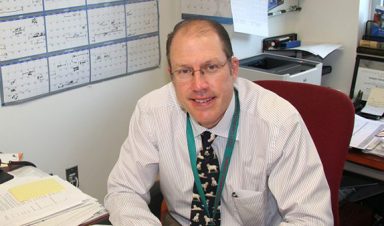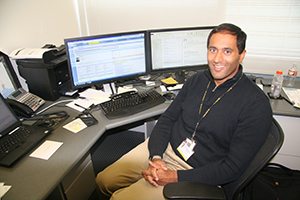The recent addition of Jay Pal, MD, PhD, to the Division of Cardiothoracic Surgery at the University of Colorado School of Medicine both maintains and deepens its expertise in treating heart failure and other serious cardiac problems. It’s also gained a guy who would rather focus on teamwork than individual achievement.
Pal joined the team June 19 after nearly four years with the University of Washington in Seattle, where he honed his skills in heart transplant surgery and implantation of left ventricular assist devices (LVADs) and other mechanical tools that support circulation in heart failure patients. He’s successfully retrieved and transplanted donor organs from remote areas in Alaska, pushing the boundaries of time for safe transplant. He’s developed expertise in less invasive techniques for LVAD surgery. For patients with acute cardiac problems, Pal has worked extensively with methods of short-term circulatory support, such as extracorporeal membrane oxygenation (ECMO).
 Pal takes over as surgical director of the Mechanical Circulatory Support Program from Joseph Cleveland, MD, who remains active with the CT team as a surgeon and research leader.
Pal takes over as surgical director of the Mechanical Circulatory Support Program from Joseph Cleveland, MD, who remains active with the CT team as a surgeon and research leader.
These and other skills strengthen not only the cardiothoracic (CT) surgery team but also the Heart Failure Program at CU and UCHealth University of Colorado Hospital. They also contributed to Pal’s selection as surgical director of CU’s Mechanical Circulatory Support Program. He takes over from Joseph Cleveland, MD, who has headed the program since its inception in 2001.
Don’t expect Pal to focus on these accomplishments when he talks about what motivates him, though.
“As a surgeon, caring for patients with heart failure requires good collaboration with management by my cardiology colleagues,” Pal said. “Physicians tend to work in silos, but heart failure requires multispecialty care by skilled specialists and nurses in the ORs, ICUs and clinics. That reflects my personality. I have something to learn from everyone. It’s foolish to think I can do anything alone.”
New shoes
Pal’s arrival fills a vacancy created about a year and a half ago with the departure of Ashok Babu, MD, for Saint Thomas Heart in Nashville. With last year’s addition of Muhammad Aftab, MD, the CT surgery team is positioned to rebuild its annual LVAD volume to its past peak of 50 or so, Cleveland said. It performed 36 such procedures last year.
 Cardiac Transplantation Program Director Amrut Ambardekar, MD, welcomes the experience and expertise that Pal brings to CU and University of Colorado Hospital.
Cardiac Transplantation Program Director Amrut Ambardekar, MD, welcomes the experience and expertise that Pal brings to CU and University of Colorado Hospital.
“The number of cardiac surgeries we do has been increasing generally,” added Amrut Ambardekar, MD, director of CU’s Cardiac Transplantation Program. “Jay not only fills a void in staffing but will allow us to grow to the next level.”
With Pal taking on the surgical director’s administrative duties, Cleveland will also have more time to pursue his research interests while maintaining his surgical schedule. He’s principal investigator for the clinical trial of the HeartMate 3 LVAD, which in late August received FDA approval as a short-term LVAD for patients awaiting heart transplant. Cleveland said he also plans to increase the CT surgery team’s involvement with CU’s Structural Heart Program, which offers minimally invasive procedures that are increasingly in demand, such as transcatheter aortic valve replacement (TAVR).
Cleveland said he’s confident that he can take on these new challenges, thanks to Pal’s mix of experience in areas both familiar and new to the CU program.
“We wanted someone who is mid-career who can, at the same time, bring outside ideas and help to make us better,” Cleveland said. “Jay also impressed us as thoughtful and collaborative, someone who would be a good colleague.”
Extending ECMO
The ECMO program promises to be another beneficiary. The technique involves providing mechanical circulation support for patients with acute heart and/or lung damage from heart attacks, arrhythmias, or viral infections, for example. The machine boosts circulation and breathing, giving injured organs a chance to rest and heal, sometimes as a bridge to an LVAD or transplant.
“There is an urgent need in Denver and beyond for care for people who get very sick, very quickly,” Pal said. “These patients would otherwise die. With aggressive care, we can salvage their organs and their lives.”
Ambardekar said the number of ECMO cases grew from 40 in fiscal year 2016 (which ended June 30, 2016) to 50 in fiscal year 2017. The program also earned the ELSO Gold Level Award of Excellence for excellence in patient care, training, education and other criteria for measuring and evaluating organizations that use ECMO to treat patients.
Longer reach
Pal also promises to help the Transplant Program extend its reach in retrieving donor hearts for patients on its waiting list. The traditional “upper limit” for bringing a heart from the field to the surgical table is four hours, Pal said. But he and his colleagues at the University of Washington often pushed beyond that boundary, sometimes flying from Seattle to deep into the Alaskan interior or far down the coast to Southern California to get and bring back a lifesaving heart. They regularly kept the organs viable for six hours and more, he said.
One key to the success was a new technique that keeps the donor heart perfused with warm blood during transport. Even more important, Pal said, was donor selection and timing. “It’s important to have healthy young donors,” he noted. “The surgery must also then be expeditious. The distance should be a minor factor in our decision making.”
His experience should help the CU team expand the area it travels for donor organs, Ambardekar said. “We’ve generally not gone more than 1,000 miles, but Jay is used to traveling longer distances,” he said. “For our patients waiting for a transplant, the farther we can go for organs, the better.”
That capability also promises to be important because the United Network for Organ Sharing (UNOS) is preparing to implement changes to its adult heart allocation system. One of them will expand the geographic area available to institutions to procure hearts for its sickest patients.
As Pal put it, “The number of people with heart failure is growing, but the donor population is still relatively fixed. That means our ability to get hearts to those who will benefit the most is paramount.”
Cutting down on cutting open
Meanwhile, Pal also has experience with surgical alternatives to opening the sternum for implantation of LVADs. Instead, surgeons make a much smaller incision in the chest wall. The idea isn’t about saving time – in fact, the procedure is more difficult and takes longer than opening the chest, Pal said. It’s aimed at sparing patients who get LVADs as a bridge to heart transplant a second sternotomy when they receive their new hearts, he said.
Cleveland said he’s done one of the less-invasive procedures, but having it more available as an option for patients is important for the CT surgery team as a whole. “We want to bring in new techniques as we move forward,” he said.
A considerable number of patients at UCH stand to benefit from having the choice. Half of the patients who received heart transplants in 2016 were those who received LVADs as a bridge, Ambardekar noted.
“Ultimately the transplants for those patients could be better, safer, faster and involve less bleeding” if they have a minimally invasive procedure to implant their LVADs, he said.
In touch with outreach
The ultimate goal all these procedures is to help patients live better lives, and that requires educating and staying connected, not only with them, but with their providers. University of Washington is in a bigger and more competitive market than Denver – at least in terms of the availability of tertiary and quaternary care – but like their Denver colleagues, Seattle specialists serve patients from a large swath of thinly populated rural communities in the eastern portion of Washington. Pal is familiar with the importance of reaching out to community cardiologists to help them care for their heart failure patients and keep them close to home as much as possible.
Pal plans to join Cleveland, Ambardekar and others on trips to places like Greeley and Cheyenne, Wyoming to meet with primary care providers and cardiologists. They offer tips on treating heart failure and explain the basics of operating, monitoring and maintaining LVADs. Cleveland said he and his team have also hosted groups of community cardiologists at UCH to observe how patients are selected to receive LVADs and transplants. Community providers with questions can also call in to a 24-hour help line staffed by the hospital’s Mechanical Circulatory Support Program coordinators.
“It’s two-way communication,” Cleveland said. “Patients know we are not here to supplant their community providers. We’re here to help manage complex medical situations.”
“My goal is to help patients not just live longer, but to go back to doing the things they want,” Pal said. “It’s not about our program getting all the patients. It’s about serving as a resource for patients and their providers.”
Still a relative newcomer to the Rocky Mountain region, Pal said he looks forward to skiing, camping and hiking with twin daughters Aliana and Isabella (not quite 3 years old) and wife, Angela. While he points to the similarities between the clinical programs in Washington and Colorado, he’s looking forward to experiencing one difference as autumn in Seattle and Denver approaches.
“The sunshine here is quite nice,” he said.
